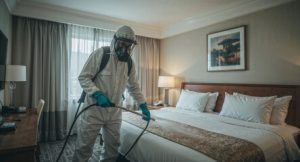Pest Control Port St Lucie plays a critical role in maintaining safe, sanitary, and comfortable environments for both residential and commercial properties. When pests invade, they bring health risks, structural damage, financial burdens, and significant stress to individuals, families, and businesses. From insects and rodents to more complex infestations, pest-related problems can escalate quickly, often long before visible signs appear. This is why effective pest control solutions are essential—not only to eliminate existing issues but also to prevent future invasions. With growing awareness of sanitation and long-term property care, more people are seeking professional pest control services that offer lasting protection, sustainable methods, and improved safety.

Pests tend to infiltrate structures quietly, often nesting in hidden spaces such as attics, basements, wall voids, and crawlspaces. Because they thrive in dark, moist, and undisturbed areas, early detection is not always easy for property owners. Many pests reproduce rapidly, meaning a small, unnoticed issue can evolve into a major infestation within weeks or even days. This is especially true for insects like termites, cockroaches, and ants, which operate in colonies and strategically spread through structures in search of food and water sources. Rodents, on the other hand, can squeeze through exceptionally small openings, chewing through insulation, wiring, wood, and various materials as they build nests. Recognizing the early warning signs and acting quickly is essential for minimizing damage and restoring a safe environment.
Professional pest control services provide an advanced level of inspection and identification that goes far beyond surface-level assessments. Trained technicians are able to identify the type of pest present, determine the severity of the infestation, and uncover the hidden entry points that allowed pests into the structure in the first place. This thorough evaluation is crucial because effective pest control requires tailored treatments. What works for ants may not be suitable for termites; what eliminates rodents may not address a cockroach infestation. Through careful inspection and detailed reporting, pest control experts can recommend precise solutions that target both active pests and the conditions that encourage them to return.
Modern pest control emphasizes environmentally responsible approaches designed to minimize risks to humans, pets, and nature. Instead of relying solely on harsh chemicals, today’s pest control strategies often use advanced materials and integrated pest management methods. This approach focuses on combining preventive measures, habitat modification, physical barriers, monitoring systems, and selective treatments to achieve long-term results. Not only does this reduce unnecessary chemical use, but it also enhances safety and sustainability. Homeowners and businesses can rest assured knowing their properties are being protected with science-backed solutions that prioritize health and environmental responsibility.
One of the greatest advantages of professional pest control is its emphasis on prevention. Eliminating visible pests is only part of the solution; preventing them from returning is what ensures long-term safety and peace of mind. Regular inspections and scheduled treatments help create a protective barrier around properties, reducing the likelihood of recurring issues. Preventive pest control is especially valuable in areas prone to seasonal pest activity, moisture problems, or dense vegetation. By treating exterior perimeters, sealing cracks, eliminating food sources, and monitoring problem areas, professionals help maintain consistent pest-free conditions year-round.
Health protection remains a major reason to invest in pest control. Many pests pose serious health hazards, carrying bacteria, allergens, and pathogens that can compromise well-being. Cockroaches can trigger asthma and allergies, while rodents contaminate food and surfaces with harmful microorganisms. Mosquitoes, fleas, and other biting insects can irritate or transmit infections. Without proper intervention, these risks can escalate quickly, especially in environments with vulnerable individuals such as children, older adults, or those with compromised immunity. Pest control services help eliminate these threats by removing dangerous pests and reducing conditions that support their growth and spread.
Structural protection is equally important. Some pests, such as termites, carpenter ants, and wood-boring beetles, cause significant damage to wooden structures. Their ability to consume or weaken wood can compromise a home’s foundation, support beams, and overall integrity, often resulting in costly repairs. Rodents can also cause extensive problems by gnawing on electrical wires, which raises fire risks, or by damaging insulation materials that contribute to energy efficiency. Professional pest control helps protect the physical structure of buildings by addressing invasive pests before they cause irreversible harm. Early detection and targeted treatment can save thousands of dollars in repairs and preserve the long-term value of the property.
For beginners or property owners unfamiliar with pest behaviors, pests often seem unpredictable or unavoidable. However, most infestations stem from identifiable factors and preventable vulnerabilities. Professional pest control experts often educate property owners about these factors, helping them understand how to reduce risk. This educational guidance empowers individuals to take proactive steps that support long-term pest prevention and property protection.
Here are two key categories of vulnerabilities that commonly lead to pest infestations:
- Environmental Attractants
- Properties with excessive moisture, food debris, standing water, overgrown vegetation, or poor waste management often attract pests. Addressing these attractants significantly reduces the likelihood of pest activity.
- Structural Entry Points
- Gaps around windows, cracks in foundations, broken screens, damaged roofing, and unsealed utility lines allow pests to enter with ease. Sealing these openings is critical for maintaining a pest-free environment.
By addressing these areas, property owners can significantly reduce the risks of pest activity and improve the effectiveness of professional treatments.
Businesses, in particular, rely heavily on pest control services to maintain hygiene standards, protect inventory, and ensure compliance with regulations. In food-related industries, hospitality, storage facilities, healthcare environments, and manufacturing, cleanliness is not just a preference—it is a legal requirement. A single pest sighting can result in violations, damaged reputations, and loss of customer trust. Professional pest control programs designed for commercial clients often include routine inspections, detailed reporting, preventive barriers, and early detection systems. These services help businesses stay compliant, maintain smooth operations, and preserve a healthy working environment.
Homeowners also benefit greatly from expert pest control. For many households, the presence of pests can cause anxiety and disrupt daily life. Strange noises in the walls, droppings, property damage, or unexpected insect sightings create discomfort and concern. Professional pest control technicians provide reassurance through thorough inspections, reliable treatments, and follow-up care. They also offer guidance on cleaning routines, landscape management, and home maintenance practices that support a pest-free lifestyle. With ongoing support, homeowners can maintain comfortable and safe living spaces without worrying about recurring pest issues.
Technology continues to enhance pest control methods, offering more efficient, precise, and environmentally friendly solutions. Digital monitoring devices, improved baiting systems, heat treatments, and eco-friendly materials allow pest control experts to address infestations with greater accuracy. Technological advancements help shorten treatment times, reduce chemical exposure, and provide real-time data for better decision-making. These innovations ensure that modern pest control remains effective even as pest behavior evolves with climate changes and environmental shifts.
Financially, investing in pest control is a long-term cost-saving measure. While some property owners believe that do-it-yourself techniques can control pest issues, these methods often provide only temporary relief. Over-the-counter products may eliminate visible pests but rarely address nesting areas, breeding sites, or root causes. Professional pest control, however, tackles every stage of pest development and includes preventive measures that limit future infestations. By preventing structural damage, reducing health risks, and minimizing emergency repairs, pest control services provide substantial economic benefits. In many cases, the cost of ongoing preventive care is far lower than the expense of repairing severe pest-related damage.
To further understand what makes professional pest control effective, it is helpful to consider two core components that drive long-term success:
- Accurate Identification and Customized Treatment Plans
- Without identifying the correct species, behavior patterns, and nesting areas, no treatment plan can be fully effective. Customized solutions allow professionals to target the specific pest with the appropriate method, ensuring thorough elimination.
- Preventive Maintenance and Monitoring Systems
- Pest control is not a one-time service. Ongoing monitoring and preventive barriers ensure that pests do not return. These systems help maintain long-term protection, reduce recurrence, and provide early warnings when new threats arise.
These components work together to create stronger, more reliable pest control strategies that protect properties year-round.
In conclusion, pest control is an essential part of maintaining safe, sanitary, and healthy environments. Whether for homes or businesses, effective pest management safeguards property value, prevents the spread of disease, and ensures long-term peace of mind. Through advanced inspection techniques, sustainable treatments, preventive strategies, and continuous monitoring, pest control professionals provide comprehensive solutions that address both immediate concerns and future risks. As pests continue to adapt and environmental conditions evolve, investing in reliable pest control services remains one of the most important decisions property owners can make. A proactive, informed approach to pest control not only eliminates current infestations but also builds a foundation for lasting protection, safety, and comfort.
